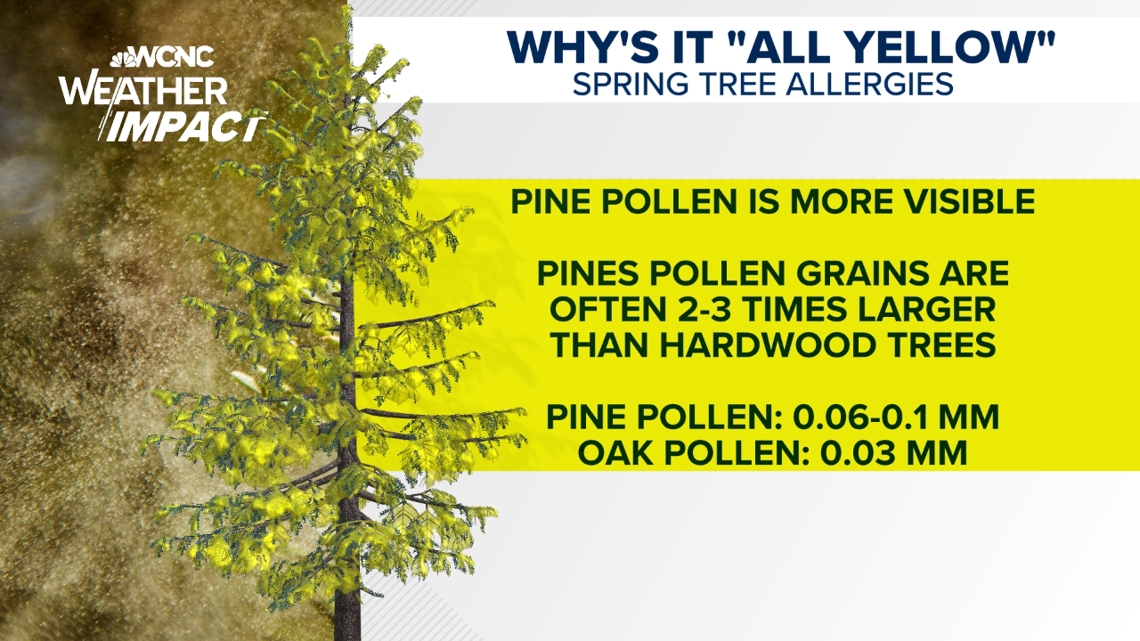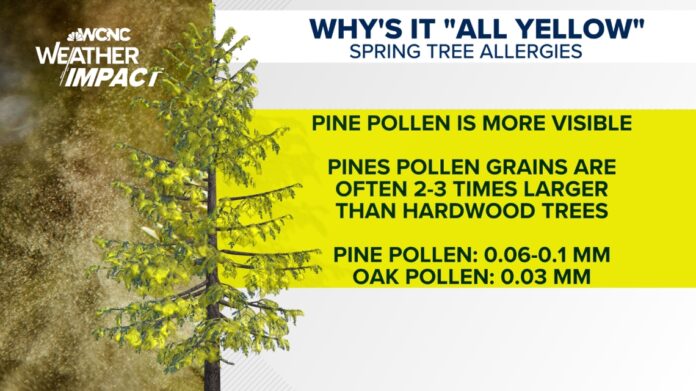North Carolina’s yellow pine pollen, peaking late March to early April, typically diminishes by mid-April and subsides by early May.
CHARLOTTE, N.C. — Yellow coated cars, yellow driveways and yellow lawn chairs. That yellow pollen is a nuisance, but when will it be gone?
First off the visible yellow dust that covers every surface across North Carolina is pine pollen. This typically peaks in late March through the first part of April. The exact timing for the peak every year varies on the weather that spring. More rain or wind will lower or increase levels and fluctuate them through the season affecting the end date.
But in general, you can usually expect the yellow coating to begin diminishing by mid-April. It doesn’t go away completely right away but by late April to early May, the heavy yellow pine pollen dusting typically subsides significantly. The more rain you get during this time period helps.
The safest bet for when North Carolina is almost entirely free from that yellow pine is by mid-May but again several days of rain will make that yellow-free window arrive sooner.
The 2025 Window
According to the numbers now, it may be safe to do a final pollen hose down once we end April.
Some upcoming rain chances in the last week and a half will help and are factored into this estimation.
The timeline of tree pollen season
North Carolina’s tree pollen season typically runs from February through the end of May. The season follows a predictable pattern:
- Early season (February-early March): Juniper, maples, and elm trees release the first wave of pollen
- Peak season (late March-early April): Pine trees produce the visible yellow pollen that blankets surfaces
- Late season (mid-April-May): Oaks, hickory, and ash trees continue releasing pollen as the season winds down
The notorious yellow coating that appears on cars and outdoor surfaces comes primarily from pine trees. While highly visible due to its bright color and larger grain size (0.06-0.1 millimeters), pine pollen is actually less allergenic than the smaller pollen from hardwood trees.


When is the allergy relief?
For those suffering from tree pollen allergies, relief typically comes in stages:
- Pine pollen (the yellow dust) usually subsides by mid-April
- Hardwood tree pollen tapers off gradually through May (Hickory and Oaks are typically the last ones to pollinate in the Carolinas)
- By early June, most tree pollen production ceases entirely
In general pollen seasons are starting earlier and lasting longer in recent years, sometimes beginning a week earlier than historical patterns.
Couple more pollen notes
- During pollen season, counts tend to rise after sunrise, peak in mid-morning and decline through the afternoon.
- Weather conditions significantly impact daily levels
- Dry, warm, windy days produce higher pollen counts
- Rain and humidity temporarily reduce airborne pollen
- Late-season frosts can damage tree flowers and reduce overall pollen production
- Mornings after rainfall often provide the lowest pollen counts.



